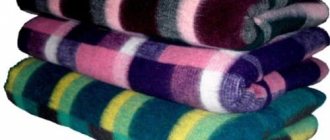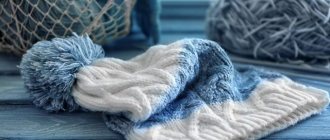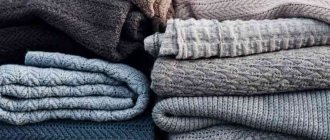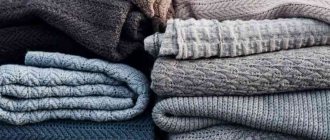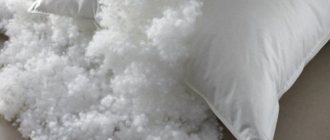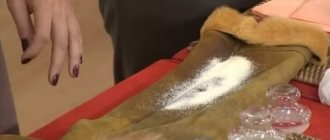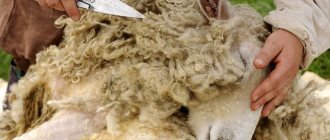The wool produced by a sheep is a unique natural product, and blankets made from sheep wool have many beneficial properties. Wool contains lanolin, which has a beneficial effect on your health. A blanket is one of the bedding items that people use in everyday life. After a certain time, it may need to be removed and cleaned. How to wash a sheep's wool blanket?
It must be said right away: washing wool blankets is hard work and requires physical effort.
You can always take it to the dry cleaner for cleaning if finances allow. We would recommend hand washing quilts and fur blankets using your feet! Next we post a photo of such a wash!
Which blankets can be washed?
Before putting a natural blanket into the water, you should decide what type it is: closed, woven or fur. Each of these products has its own characteristics.
- Closed or quilted are easy to care for, so they are most in demand. They consist of a woven cover and filler stitched together with it. This type of blanket can be refreshed in any way: machine washed, hand washed, or brushed.
- The natural layer of a seamless product is not protected by anything, so it easily loses its appearance. This wool blanket is more demanding to care for than a quilted one. At home, gentle cleaning methods are suitable for it: hand wash or dry.
- Open fur fabrics (especially double-sided ones) are the most demanding to care for. Natural wool pile does not tolerate water very well. It is best to take such blankets to the dry cleaner or use the dry cleaning method.
Features of sheep wool
The product of processing the hair of sheep of various breeds contains a special substance - lanolin, the so-called natural wax. When interacting with human skin, this natural antiseptic penetrates the pores and has a healing effect on the human body.
Lamb
Home textiles made from natural sheepskin provide a relaxing effect and relieve insomnia. Wool products are recommended for use by those who suffer from:
- arthrosis;
- rheumatism;
- osteochondrosis;
- muscle pain;
- allergies;
- asthma;
- circulatory disorders.
The peculiar structure of wool fibers contains a large number of air cavities, which makes the blanket:
- hypoallergenic;
- absorbs moisture well.
The evenly distributed natural filler is not electrified and does not attract dust particles.
Sheep wool has a positive effect on the development of children: it improves their muscle tone and blood circulation, and serves as a prevention of colds.
Thanks to the air between the fibers, sheep wool products retain their shape well. The elasticity of raw materials allows products to quickly return to their original state after use.
Preliminary preparation
Before any type of washing with water, a sheep wool blanket should be prepared:
- Any type of canvas must be freed from dust. What happens if you skip this step? After soaking, dust will appear on the surface in the form of dirty streaks or lumps. Removal methods: spread the product horizontally and thoroughly vacuum it; or hang it on a bar or rope, and then carefully, without intense pressure, clean it with a broom or brush; Lightly knock it out with a plastic carpet shovel.
- Clean stains, moving from the edges of the stain to the center.
- Before washing a quilt, you need to check the integrity of the woven cover, as well as the seams connecting it to the filling. During the washing process, wool will come out through damaged areas and become matted. Therefore, such defects must be eliminated.
What do the icons on the tag mean?
To properly care for a sheep's wool blanket, you must carefully study the manufacturer's recommendations on the product tag. You should take prohibition signs especially seriously so as not to spoil the item.
Labels typically contain five basic types of characters:
- wash;
- whitening;
- drying;
- ironing;
- professional cleaning.
Table of signs on clothing
Additional images inside the signs indicate a specific regime or requirement:
- The number on the wash icon shows the maximum permissible water temperature.
- The dots on the “iron” indicate the permitted ironing temperature.
- A crossed out sign prohibits action.
- Recommendations for the direction of drying (vertical or horizontal) can be understood by the lines inside the symbol.
- The letters in the professional cleaning icon regulate the treatment methods.
Most often, the following symbols can be seen on the tags of sheep wool products:
- Hand/machine wash recommended;
- bleaching is prohibited;
- ironing is not recommended;
- Dry/wet professional cleaning is allowed.
The manufacturer will also indicate the permissible temperature conditions and type of drying.
Foam cleaning
The most gentle way to return a wool covering to its presentable appearance is cleaning with foam. Conventionally, it is called “dry”, although water and detergents are used for this process. Clean a blanket with wool in the following sequence:
- Lay the product on a horizontal surface, placing a cloth or oilcloth under it.
- Dilute a liquid detergent containing lanolin, which has a beneficial effect on wool, in warm water (30°C). Beat it into a fluffy foam.
- Using a dry sponge, apply foam to contaminated areas or distribute it over the entire surface, drawing horizontal stripes from one edge to the other.
- When the solution is completely dry, clean the blanket. A vacuum cleaner with a plastic attachment or a dry brush will help with this.
- For a better result, the canvas is additionally wiped with a slightly damp cloth, and then allowed to dry unrolled. After cleaning, the fur pile is combed, this will restore its volume and softness.
Foam will only refresh the surface of the product and help get rid of stains. Heavily soiled items must be washed.
How to additionally care for sheep wool blankets
Blankets and blankets made of sheep wool, in addition to washing and drying, require additional easy care:
- in regular ventilation and drying in the open air without access to direct sunlight (at least once a year);
- to protect against stains and other contaminants - a duvet cover should be used for this purpose;
- stored in a fabric bag, sheet or duvet cover, but not in a plastic bag!
Important: wool blankets should not be ironed.
When using cozy and comfortable products made from sheep wool, strictly follow all manufacturer’s recommendations and additional care tips. This way you will extend the life of your favorite things, preserve their original appearance and high consumer qualities for a long time.
Handwash
Hand washing a natural sheep wool blanket includes the following steps:
- Fill the bath with warm (30-35°) water at least halfway.
- Add a gel wool detergent, preferably containing lanolin, and dissolve it completely.
- Place the straightened product in water and leave for a quarter of an hour.
- Wash carefully, squeezing the fabric in different places, lifting and turning it over in the water. Do not rub dirt; they must be cleaned at the preliminary preparation stage or a soap solution must be applied to them in advance.
- Lightly wring out the blanket and, moving it to the edge, change the water in the bath. You cannot pour it directly onto the item.
- Repeat the manipulation 3-4 times until the water becomes clear.
To ensure that the blanket does not lose its softness after contact with water, you need to follow several rules:
- Do not use hot for washing - the blanket will be deformed;
- dissolve the gel or shampoo in water first, rather than pouring it onto the product;
- It is advisable to use liquid detergents; it is very difficult to rinse out the powder or to bring it until the granules are completely dissolved;
- do not soak the item for longer than 15-20 minutes - the wool will become saturated with water and become matted;
- It is strictly prohibited to twist or rub the product.
Washing a sheep's wool blanket by hand is literally not an easy task. Once wet, the product becomes very heavy, so before putting it in the water, you should calculate your strength.
Let's start washing
Blankets made from sheep wool are light, warm, environmentally friendly - you can’t count all the advantages! And as you know, you quickly get used to good things, moreover, you literally fall in love with such things. Therefore, no one would want the blanket to be damaged after washing. The best option: clean it depending on what and how much it is dirty. The following washing methods are suitable, which will be discussed in more detail below:
- dry cleaning (or foam cleaning);
- handwash;
- washing in a washing machine;
- dry cleaning
You can easily find out whether these methods can be used by looking at the label. As a rule, you can find the following information on it:
- ban on washing;
- ban on ironing;
- ban on bleaching;
- ban on centrifuge drying;
- gentle dry cleaning mode.
Just prohibition signs! Therefore, after studying the label, the housewife may doubt: is it still possible to use the washing machine, since the label prohibits this? You can care for your blanket according to the manufacturer's instructions and have it dry cleaned each time. However, practice shows that delicate hand washing and washing in a washing machine are not contraindicated if you are careful and follow the recommendations for cleaning woolen items. Thus, the answer to the question of whether a wool blanket can be washed is yes.
Pure sheep wool
Now let’s figure out which cleaning option to give preference to in a particular situation. Dry cleaning should be chosen in case of light occasional surface contamination. In other words, a stain that appears on the blanket needs to be treated with foam, without soaking it entirely. If the contamination is more severe, it has penetrated deeper - for example, if something was spilled on the blanket - you will have to wash it without waiting for the fibers to fall off and it to become saturated with a foreign smell.
We recommend: Selecting a mode for washing a down jacket in a washing machine
The ideal option is to take the blanket to the dry cleaner or call a specialist from a cleaning company. This is fully consistent with the manufacturer’s information about proper cleaning and does not require any effort or effort, but the method is quite expensive. Another option is to wash the blanket. We have already considered the question of whether it can be washed and came to the conclusion that it is possible. If only this procedure takes place according to the rules.
Useful tips - sheep wool blanket:
- should be protected from contamination and washed as rarely as possible;
- you need to wash with a product that contains lanolin;
- cannot be ironed;
- must be dried on a horizontal surface;
- Do not dry near radiators or in direct sunlight;
- cannot be squeezed in a centrifuge;
- cannot be twisted;
- It is useful to air your sheepskin blanket from time to time to eliminate unpleasant odors.
Machine washable
First of all, you need to study the product label and make sure that the manufacturer allows automatic washing and that the size of the blanket is suitable for your machine. If it fits with difficulty or right next to each other, then it is better to refuse washing and not to overload the equipment.
It is much easier to clean a blanket in a washing machine than by hand. But here too you should proceed with caution.
- Place the item correctly in the drum. Closed models are rolled up like a snail, while woven and fleecy ones are pre-placed in a mesh or fabric bag (duvet cover).
- Depending on the type of machine, the “delicate wash” or “wool” mode is set. Temperature 30°C. You can also use the “baby comfort” mode, which involves additional rinsing.
- A liquid product with lanolin for wool is poured into the powder compartment and the spin mode is turned off or the minimum speed is set. After this, the machine can be turned on.
Automatic washing
Before you start washing sheep wool in the machine, you need to roll it up. This way it will load better into the drum. Then you need to:
- turn on the “Wool” or “Hand Wash” mode at temperatures up to 30 degrees;
- use the extra rinse function without spinning.
Next, as after washing by hand, let the water that the product has absorbed drain off and dry it.
Do you turn off the water tap after washing?
Oh yes! No.
Proper drying
The key to a good result is not only proper washing, but also drying. It is carried out in several stages.
- Even after machine washing, the product will be soaked in water. Therefore, first you need to let it drain, placing it on stools placed inside the bathroom or on a wooden grate.
- Lay out towels or cloth on the floor or large table and place a blanket on them. After some time, the wet litter needs to be changed and the canvas turned over.
- Once the blanket is slightly damp, you can hang it on a line or drying rack, but not on a radiator or in direct sunlight.
- After the blanket has completely dried, it is recommended to shake it thoroughly, this will restore its fluffiness and softness.
If possible, it is best to dry it outdoors. In this case, the pile must be covered with a thin cloth so that it does not fade in the sun. If conditions do not allow, you can use a fan. In any case, the process cannot be delayed, otherwise the wool will acquire a musty smell.
Might be useful: How to wash a cotton blanket.
photo: depositphotos.com/monkeybusiness
Proper care
Experienced housewives share their secrets for caring for wool textiles and recommend:
- wash the blanket in the duvet cover so as not to clog the machine drum filter with lint;
- shake the washed product thoroughly to restore its airiness and softness;
- When drying, place a light sheet over the blanket to protect from direct sunlight;
- do not wash such items more than once a year;
- Temporarily hide the unused blanket in a vacuum bag.
